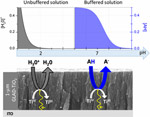Publication
827
J. Phys. Chem C, 121 (19), 10325–10335, 2017
DOI:10.1021/acs.jpcc.7b02395
|
|
|
|
|
|
 |
Evidencing Fast, Massive, and Reversible H+ Insertion in Nanostructured TiO2 Electrodes at Neutral pH. Where Do Protons Come From?
|
|
|
|
Yee-Seul Kim, Sébastien Kriegel, Kenneth D. Harris, Cyrille Costentin, Benoît Limoges, and Véronique Balland
Laboratoire d’Electrochimie Moléculaire, UMR CNRS 7591, Université Paris Diderot, Sorbonne Paris Cité, 15 rue Jean-Antoine de Baïf, Paris F-75205 Cedex 13, France
NRC National Institute for Nanotechnology, Edmonton, Alberta T6G 2M9, Canada
Department of Mechanical Engineering, University of Alberta, Edmonton, Alberta T6G 2V4, Canada
Leibniz-Institute für Polymerforshung Dresden, 01069 Dresden, Germany
Ongoing developments of sustainable energy technologies based on high-surface-area semiconductive metal oxide electrodes operating under mild and safe aqueous conditions require deep understanding of proton and electron transfer/transport throughout their porous structure. To address this issue, we investigated the electrochemical reductive protonation of high surface area nanostructured amorphous TiO2 electrodes (produced by glancing angle deposition) in both buffered and unbuffered aqueous solutions. Quantitative analysis of the two charge storage mechanisms was achieved, allowing proper deconvolution of the electrical double-layer capacitive charge storage from the reversible faradaic one resulting from the proton-coupled reduction of bulk TiO2. We evidence that this latter process occurs reversibly and extensively (up to an intercalation ratio of 20%) not only under strongly acidic pH conditions but also, more interestingly, under neutral pH with the intercalated proton arising from the buffer rather than water. Moreover, we show that in comparison with reductive Li+ intercalation the proton-coupled electron charge storage occurs more rapidly (in a few seconds). This important finding suggests that a high-rate and high-power charge storage device could potentially be achieved with the reversible H+-coupled charge/discharge process in TiO2 at neutral pH, opening thus new opportunities to the development of eco-friendly batteries for electrical energy storage. |

